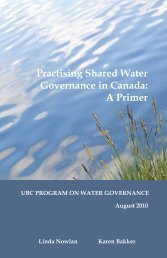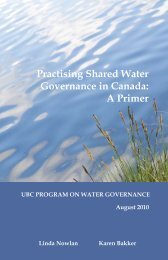Water Security Status Indicators - Program on Water Governance
Water Security Status Indicators - Program on Water Governance
Water Security Status Indicators - Program on Water Governance
Create successful ePaper yourself
Turn your PDF publications into a flip-book with our unique Google optimized e-Paper software.
WATER SECURITY GUIDANCE DOCUMENT<br />
PART 2 SECTION 4<br />
WATER SECURITY STATUS INDICATORS (WSSI)<br />
However, even if the all the above factors were adjusted the final WAI results<br />
are unlikely to change for this test community. This finding suggests the need<br />
for greater development of indicators that are accessible and sensitive at a subwatershed<br />
scale and include both supply and demand. Thus, for the calculati<strong>on</strong><br />
of the WSSI assessment method, we suggest the applicati<strong>on</strong> of more localized<br />
indicators, if available. For example, the ToL is currently undertaking<br />
a water balance study that could be applied to the WSSI assessment method.<br />
Other indicators relevant to groundwater supply include measured decline in<br />
groundwater level.<br />
To provide additi<strong>on</strong>al assessment of water quantity and quality for aquatic<br />
ecosystem health, existing studies for aquatic ecosystem health were identified<br />
and results incorporated into the overall assessment. In our case study<br />
area, the British Columbia Fish Protecti<strong>on</strong> Act has started to assess fish habitat.<br />
The Act, for the first time, provides legislative authority for water managers<br />
to c<strong>on</strong>sider status of fish and fish habitat in approval (or renewal) of<br />
licenses for development projects. This Act focuses <strong>on</strong> four key areas: “ensuring<br />
sufficient water for fish; protecting and restoring fish habitat; improved<br />
riparian protecti<strong>on</strong> and enhancement; and str<strong>on</strong>ger local government powers<br />
in envir<strong>on</strong>mental planning” (BC MoE 2011). This study provides an <strong>on</strong>-theground<br />
assessment of c<strong>on</strong>diti<strong>on</strong>s related to aquatic ecosystem health using<br />
indicators species.<br />
RECOMMENDATIONS AND FURThER AREAS FOR RESEARCh<br />
In closing, the inclusi<strong>on</strong> of stakeholders is an essential comp<strong>on</strong>ent to integrated<br />
assessment methods, as they provide valuable local knowledge, access<br />
to data sources, and l<strong>on</strong>g-term commitments to adaptive planning. We argue<br />
that assessment methods such as the WSSI may close the gap between scientific<br />
assessment, policy, and behaviour-change, particularly if these methods<br />
are flexible in nature and incorporate adaptive management and community<br />
involvement. This may, we suggest, c<strong>on</strong>tribute to attaining goals of water security<br />
at the community level and bey<strong>on</strong>d.<br />
20







